Water is essential in every garden or lawn, whether big or small. Using a water sprinkler or sprinklers to water the lawn and garden can be the difference between evenly lively green grass and a brown lawn or dying plants. Thankfully, there are different types of lawn sprinklers available today. Choosing the best will automatically result in a vibrant and healthy yard or garden.
But how do you choose the right one? Which sprinkler type is ideal for your property? If you find yourself pondering over these questions, you need not worry anymore. I will write about the various types of sprinklers and their benefits, along with factors to consider in order to get the best type for your property.
Types of lawn sprinklers
A sprinkler is a system designed to apply water in a regulated manner on a lawn, landscape, or any similar green space. There are different types of sprinklers, they include;
1. Oscillating sprinklers
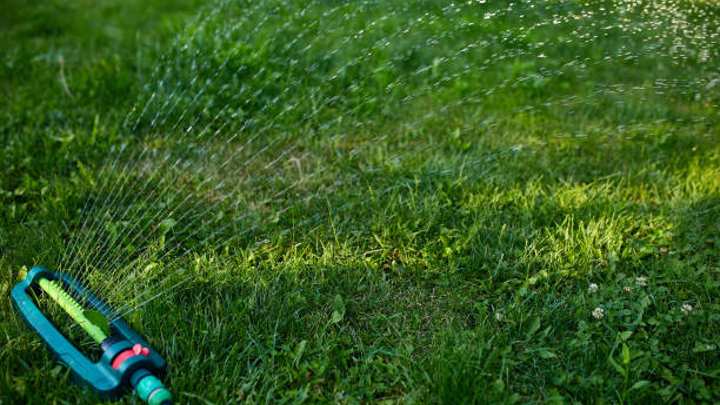
Oscillating sprinklers are probably the most common type of sprinkler, especially in the North American region. They consist of a rotating head that oscillates back and forth, spraying water on the lawn in a fan-like pattern. This type of sprinkler is ideal for watering large or medium-sized lawns.
Advantages of oscillating sprinklers
- They have a great area of coverage
- Available in both manual and automatic versions
- It can provide more effective width and length control, ensuring water is distributed better
- Sprays water evenly, meaning there will be little or no dry patches
Disadvantages of oscillating sprinklers
- It can be difficult to set up correctly
- Water can be blown about by the wind, affecting the spray pattern and leaving some areas dry
- There is the issue of damage done by pets or kids playing around the sprinkler head
- If you have low water pressure, the sprinkler might not reach every inch of your lawn
2. Stationary or impact sprinklers
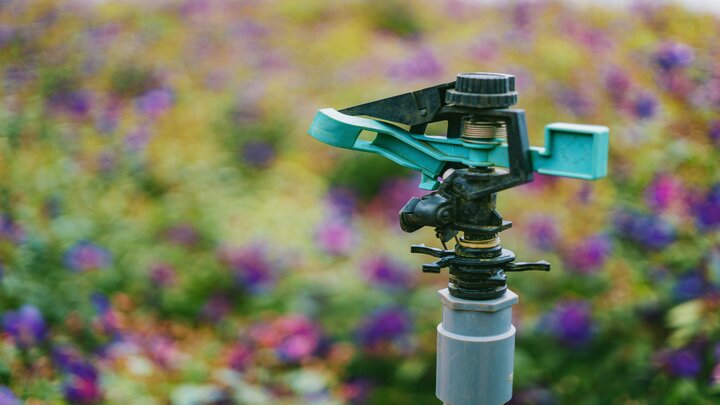
Another effective way of watering your lawn is to use stationary or impact sprinklers. These sprinklers feature a stationary base on a pole with a spinning head on top that sprays water on the lawn in a circular pattern. This type of sprinkler is perfect for watering large lawns or gardens.
Advantages of stationary or impact sprinklers
- Covers large areas
- Strong water pressure, less likely to be misdirected or blown by the wind
- Easy to set up and use
- Inexpensive
Disadvantages of stationary or impact sprinklers
- It is larger and will take up more space in your lawn than other types of sprinklers
- Does not work well in areas with low water pressure
- It may not reach the edges of the lawn, especially lawns that are square or rectangular in shape
3. Rotary sprinklers
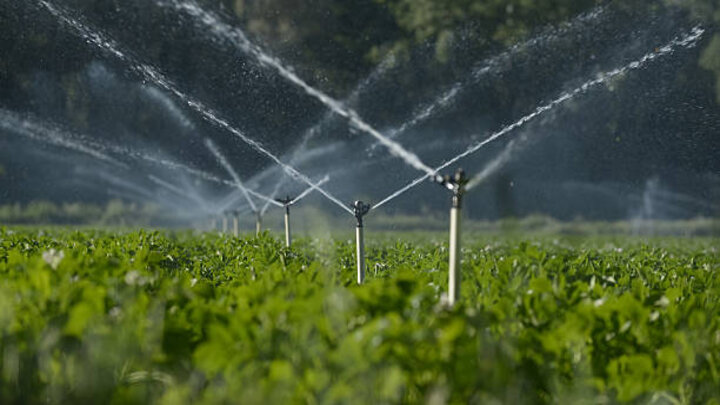
Rotary or rotating sprinklers are very similar to impact sprinklers since they both rotate, sending water flying in all directions. The rotating sprinkler features two or more arms that spin and distribute water. This type of sprinkler is perfect if you want to quickly and easily water your lawn or garden.
Advantages of rotary sprinklers
- Great coverage area
- Can get the job done quickly and easily
- The water droplets from this type of sprinkler are light so they do no damage to tender plants that are prone to harm
- Available in both electric and manual versions
Disadvantages of rotary sprinklers
- The circular spray pattern is not effective enough for rectangular or square lawns
- Water can be sprayed into areas that do not need watering
- It can be difficult to work effectively if the terrain is not flat
4. Travelling sprinklers
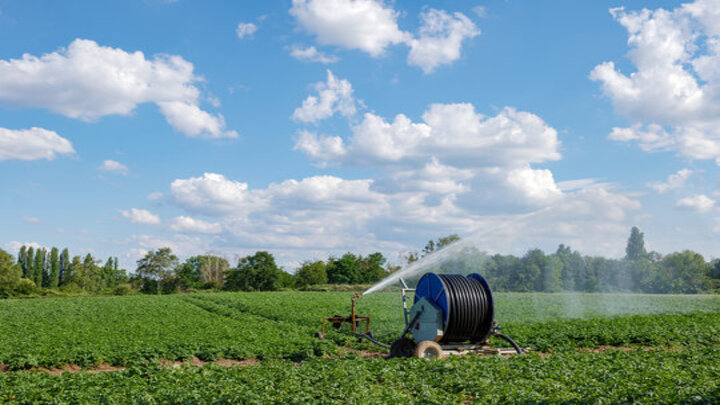
This is another type of sprinkler that is commonly used in most modern areas in the United States. They feature a tiny tractor moving on wheels along a set path, watering the area as they travel along the path. This type of sprinkler is best for watering large areas that will usually require more than one sprinkler.
Advantages of traveling sprinklers
- Can cover large areas with ease
- Low risk of overwatering since the sprinkler is constantly on the move
- Automatically water the lawn even when you are not chanced to attend to the lawn yourself
- It can be set to water for a specific amount of time and turned off after, making the operation very easy
Disadvantages of traveling sprinklers
- Not recommended for newly seeded areas
- It can be stuck if the track is damaged
- It can be very expensive
- Installation or setup is difficult
5. Pulsating or pulse jet sprinklers
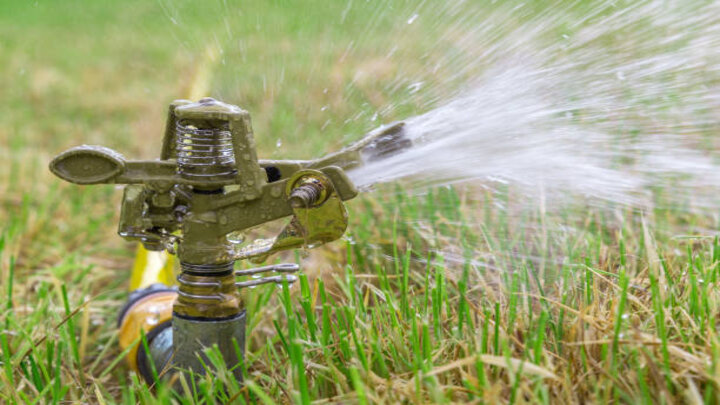
A pulsating sprinkler uses water pressure to move water through a series of nozzles. These nozzles release short bursts of water, creating a pulsating effect. This type of sprinkler is usually best suited for watering medium—or large-sized lawns quickly and easily.
Advantages of pulsating sprinklers
- Can water almost 10,000 square feet in area, that is, if the water pressure is high enough
- Can water round, rectangular, or even other irregularly shaped lawns
- Easy to set up and use
Disadvantages of pulsating sprinklers
- It can be very noisy
- Some models are difficult to adjust
- It is not conducive in areas with tender plants that are prone to damage
6. In-ground or pop-up sprinklers
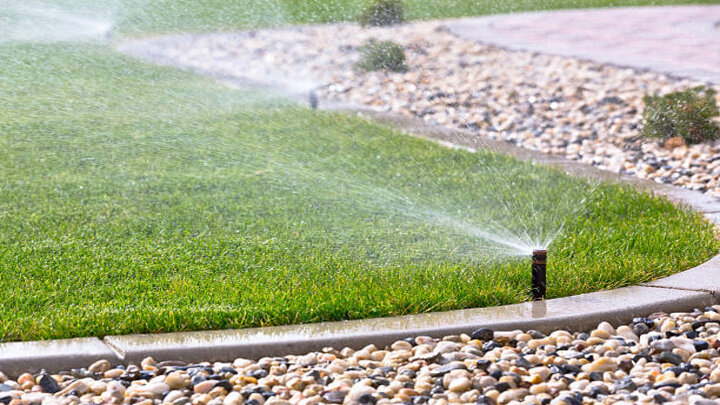
In-ground or pop-up sprinklers are installed underneath the ground and stay that way until needed. They work just like the name implies: They pop up when turned on and spray water on the lawn in a circular or rectangular pattern. This type of sprinkler is a viable option for owners who plan on living in an area for a very long time.
Advantages of pop-up sprinklers
- They are very convenient
- They water evenly and adequately
- Since they are installed underground, they are less likely to be damaged by kids or pets
- Easy to installed
- Comes with a pre-set watering schedule
Disadvantages of pop-up sprinklers
- It can be quite expensive to install
- As to be properly monitored or rescheduled during the winter, or else you might damage your lawn or garden
- Regular maintenance is needed in order to keep them working adequately
FAQs
What is the most common type of water sprinkler?
The oscillating sprinkler is the most common type of sprinkler.
What type of lawn sprinkler covers the most area?
The stationary or impact sprinkler is a powerful model that can cover a large area.
Which type of lawn sprinkler uses less water?
The stationary or impact sprinkler is excellent for low water usage.
What is the best sprinkler for an irregularly shaped lawn?
The underground or pop-up sprinkler is best for circular, rectangular, and irregularly shaped lawns.
Wrapping things up – Choosing the best type of lawn sprinkler for your lawn
As you’ve learned, there are many types of lawn sprinklers, and each has its unique feature and certain drawbacks. However, you must consider various aspects first before deciding which is best for your lawn. To help you out, simply ask yourself the following questions.
- What is the size of your lawn? (Is it square, circular, or irregularly shaped)
- Are you going to be staying for a long time or temporarily? (Certain types are more suited for long-term stay)
- What is your budget?
- What type of soil does your lawn have (can it withstand large amounts of water)
- Is the water pressure of your home right for the type of sprinkler you choose?
Figuring out these questions will definitely narrow the list down and help you to make a well-informed decision on the type of sprinkler that is best for your lawn.
I hope you found this article helpful. You should also see this article on home flooring and which is best.
Thanks for reading.